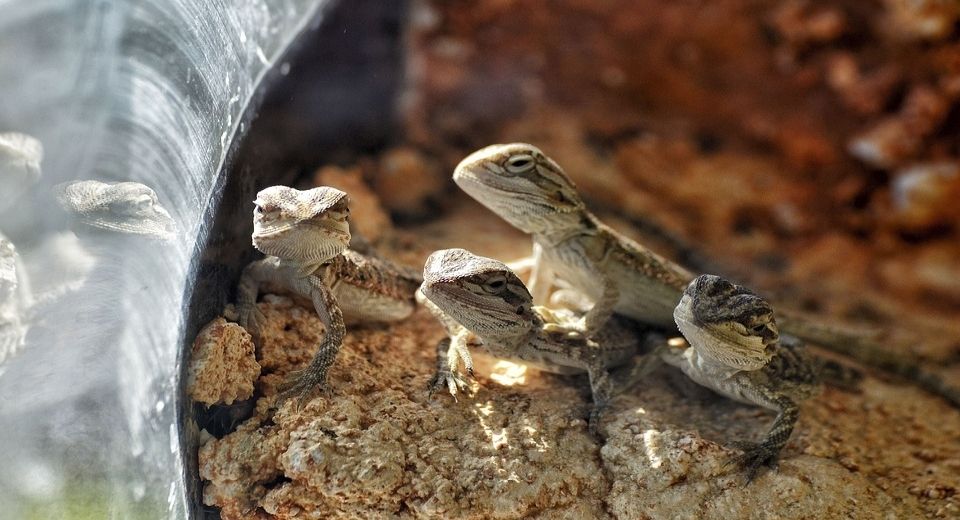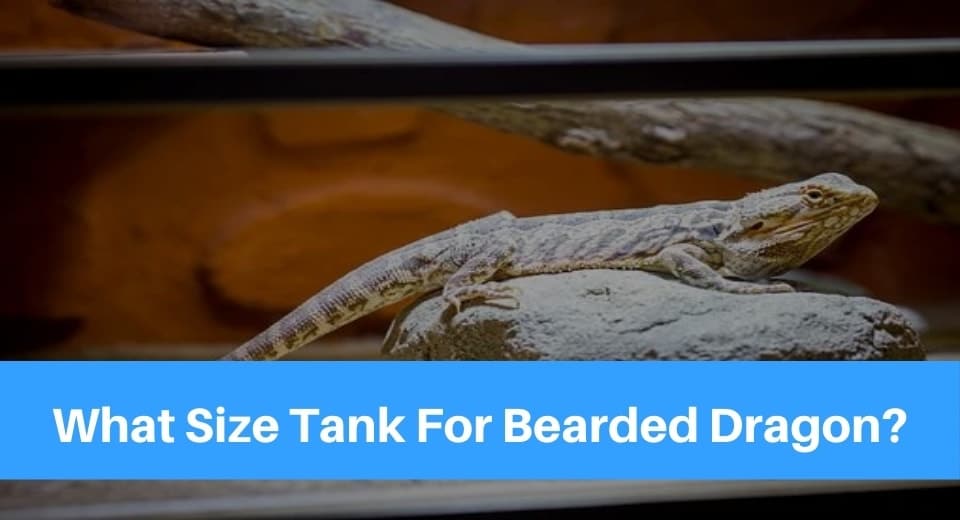To make sure your bearded dragon is happy and healthy, an incredibly important part of their life is their habitat. Before you begin setting up their home, you’ll first need to know what size tank for a bearded dragon is best, and the answer is much more complicated than you’d expect.
Importance of Tank Size
The proper tank size is essential in helping your bearded dragon grow strong and healthy. Their tank isn’t just a place for them to stay in, it helps determine how big they can grow, how active they can be, and how happy and relaxed they can be.
Choosing the right tank size for them is not as clear cut as buying the biggest one you see or buying something that’ll fit a space in your house and then never looking at tanks again.
Anything too big will make it difficult for baby bearded dragons to find their live food, which is meant to be the larger portion of their diet. Anything too small will make it difficult to have a proper temperature gradient for a clear warm basking area and a cooler area. It also stunts their growth.
Not only is the size important, but the different features attached to it are also just as essential in their growth.
Most people know bearded dragons to be very strong reptiles and amazing companions. However, to get that, they’ll need to feel comfortable in a tank that meets their needs at whatever stage of life they’re in.
Best Tank Size For Your Bearded Dragon
If you have a baby bearded dragon, it’s recommended for you to purchase at least two or three tank sizes in your beardie’s life. Its tank will upgrade the larger and older it gets.
This topic is best understood when you’re familiar with the different stages in the life of a bearded dragon, and what each stage entails.
Bearded dragons have three main stages in life as they grow older and larger: the Baby Bearded Dragon, Juvenile Bearded Dragon, and the Adult Bearded Dragon stages. Each stage requires different diet plans, care instructions, and habitats.
In choosing their tank size, the length of your beardie is much more important than its age, although they tend to grow at consistent rates with other bearded dragons in their first few months. Be sure to measure your bearded dragon from the tip of its tail up to the edge of its nose before purchasing a new tank for them.
1. Baby Bearded Dragon (0–6 months)

Baby bearded dragons typically measure anywhere from 3“ to 16” long. If your bearded dragon grows quickly and your budget allows, you might need to provide them with two tanks rather than one during this stage.
Until their first 10 inches, a 20 to 40-gallon tank would be best, which could be around their third or sixth month. Most beardies will need to upgrade their tanks to a 40 to 55-gallon tank by their fourth month, due to how much they’re growing.
While it’s the more affordable option, starting a baby beardie off with a 40 or 55-gallon tank might cause them difficulty catching live food and negatively impact their health. That said, a bigger tank size is required as they grow larger.
It’s never good to leave your beardie in a cramped space, especially during these crucial months where they grow most. Their size will be limited by the space available. Cramped spaces will also negatively affect the temperature gradient in their enclosure and cause them to feel too cold or too warm.
Whenever you place your beardie in a new tank, you must observe them closely to see how well they’re able to catch their food. If the tank is too big and they’re having trouble finding the crickets or worms, it might be best to hand feed them first while you look for a smaller tank.
Luckily, the big tank won’t be wasted since they’ll be able to use it once they grow a bit larger.
2. Juvenile Bearded Dragon (6–12 months)
Juvenile bearded dragons grow the most during this stage and are also when their sex-identifying traits show. You’ll be able to watch them grow anywhere from 11” to 20” long.
Fortunately, recommended tank sizes are much simpler with juveniles. They’re best placed in a 50 to 75-gallon tank.
This size provides them with space to grow, run around, catch their food, to sit in varying temperatures, and to entertain themselves. You’ll also be able to observe their developing habits and preferences, which you should take note of for their adult tank.
During this stage, they become much more active, and confining them to a small tank is likely to cause stress. We would never want our bearded dragons to feel stressed but this is particularly crucial to avoid while they’re growing.
By the time they grow to 18”, at least a 75-gallon tank is required. Be sure to adjust their enclosure during this stage, since females will need a nesting area prepared for laying eggs and some beardies will start looking for many activities to do.
3. Adult Bearded Dragon (12+ months)
An adult bearded dragon will measure at least 18 inches long. If they never grow past this length, a 75-gallon tank should be enough, especially if the budget is tight.
However, bigger is better for adult beardies. This will most likely be their home for the rest of their lives and you’ll want them to have enough space for them to properly exercise, bask, and catch their food.
As they become adults and reach their full size, it’s recommended that they should have at least a 120-gallon tank. While floor area will always take priority over tank height, especially as they’re growing, height will be much more important when they become adults.
As owners, the most ideal setup for your bearded dragon is one that replicates what they would be eating, doing, and living in had they been in the wild, albeit in a much safer way.
Their tank should be set up for them to be able to explore, not just stay in place. Exploring entails being able to run, bask, climb, dig, and hide, which is best done in bigger spaces.
At the very least, your bearded dragon should be able to run around in excitement without hitting any walls.
To help you decide, here are the recommended tank sizes for the different bearded dragon ages and sizes. These sizes are only recommended for single bearded dragon enclosures. If you’re keeping a pair together, double the recommended size would be good, with at least a 120-gallon tank for when they reach adulthood.
| Age | Size
(length in inches) |
Smallest Tank Size
(length x width x height in inches) |
Largest Tank Size
(length x width x height in inches) |
| Baby Bearded Dragon
(0-6 months old) |
3” – 10” | 20 gallons
(24” x 12” x 16”) |
40 gallons
(36” x 18” x 18”)
|
| 10” – 16” | 40 gallons
(36” x 18” x 18”) |
55 gallons
(48” x 13” x 21”) |
|
| Juvenile Bearded Dragon
(6-12 months old) |
11” – 17” | 50 gallons
(36” x 18” x 19”) |
75 gallons
(48” x 18” x 21”) |
| 18”+ | 75 gallons
(48” x 18” x 21”) |
120+ gallons
(48” x 24” x 24”) |
|
| Adult Bearded Dragon
(12+ months old) |
18”+ | 75 gallons
(48” x 18” x 21”) |
120+ gallons
(48” x 24” x 24”) |
Final Thoughts
Tanks occupy a small space in our homes but hold the entire life of your bearded dragon. Because of this, you’ll want to optimize their tank to their needs and preferences.
Choosing the right size will not only help them grow large, it helps keep them happy and healthy. Different ages need different tanks, and not all of them are made the same. You’ll need to consider tank expenses for when you’re thinking of getting a beardie for yourself.
There is no one true tank size for a bearded dragon but, as long as you give them enough space to grow, explore, and play, your bearded dragon will grow up happy and healthy.

